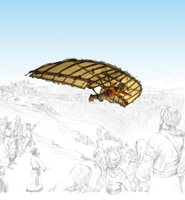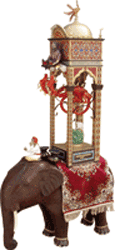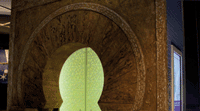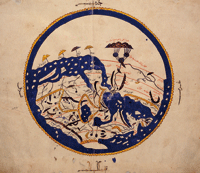Why Did It Take a Thousand Years to Discover Movies Again Science

Uncovering A Chiliad Years of Scientific discipline and Engineering science
September 2010

A colorful, fascinating and insightful exhibition – "1001 Inventions: Discover the Muslim Heritage in our Earth"1 – which ran in London's Science Museum from January to June 2010, has recently opened in Istanbul, Turkey. This unique overview of the dynamism of Muslim civilization, its ingenuity and various scientific and technological achievements, is set to visit xxx major cities beyond v continents in the next four years.
The exhibition traces the "forgotten story of a g years of scientific discipline in the Muslim world from the seventh century onwards." It reveals some of the extraordinary social, scientific and technical achievements credited to the Muslim earth and shows how many modern inventions in fields every bit wide-ranging as technology, medicine and design tin can trace their roots back to Muslim civilization.
Shedding new light on a relatively little known period of history, the exhibition demonstrates how "medieval Muslims were trailblazers in fields every bit diverse every bit medicine and mechanics, cartography and chemical science, teaching and engineering, architecture and astronomy."
The exhibition features over sixty interactive exhibits and displays that showcase impressive feats of technology. Electronic games and multimedia platforms bring to life a "Golden Age of Discovery" that had a vast but subconscious and, until recently, unrecognized influence on the mod world.
Seven zones, each representing a different sphere of scientific and cultural achievement, are featured, including:
- home (the 1,000-twelvemonth-one-time inventions that continue to influence everyday life);
- market (how influential ideas spread through merchandise and travel);
- school (pioneering developments in education);
- infirmary (how ancient approaches to health care continue to influence modern-day medical practise);
- boondocks (the influence of eastern thought on contemporary architecture);
- world (pioneering explorers who tested the limits of knowledge); and
- universe (how medieval astronomers influenced our understanding of the cosmos).

Artistic Imressions of Abbas Ibn Firnas
and his successfull 9th century flight
(Photos: 1001 Inventions Copyright 2010)
One of the key aims of the exhibition is to highlight how the people of many different faiths and backgrounds working within Muslim civilisation, which stretched from southern Kingdom of spain to China, fabricated exceptional advances and greatly improved the world's understanding of science, technology and engineering science. It underscores how ideas from many different cultures and societies take contributed to and influenced contemporary science and technology and the way we alive today.

Sir Ben Kingsley every bit Al-Jazari in the brusque film "1001 Inventions and the
Library of Secrets" (Photo: 1001 Inventions)
The exhibition, and its extensively illustrated 370-page book entitled 1001 Inventions: Muslim Heritage in our Earth highlight the various means in which Muslim scholars accept influenced our lives – from the discovery of coffee, to the invention of perfume, non to mention carpets and shampoo. Professor Al-Hassani, Chief Editor of the book , noted, "if you lot ask the average person where their spectacles or camera or fountain pen come from, few people will say Muslims. This volume takes y'all on a journeying through a thousand years of Muslim contributions in medicine, mechanics, cartography, chemical science, didactics, engineering, architecture and astronomy."
Displays reveal the mechanical genius of inventors such as Al-Jazari (1136–1206), the most outstanding mechanical engineer of his fourth dimension. Al-Jazari is credited equally a pioneer of some 50 mechanical devices, including h2o clocks, the use of a crankshaft in machines, a double-action pump that could enhance h2o to a height of 12 meters and lamination of timber to reduce warping. These and many other inventions are described in scrupulous detail in his Book of Knowledge of Ingenious Mechanical Devices, which enabled hereafter craftsmen to reproduce them.
A reconstruction of Al-Jazari's fabled elephant clock2 – a weight-powered water clock3 in the class of an elephant – is featured. Not only is this extraordinary timepiece remarkable for its mechanical innovations, information technology is as well seen equally an early example of technological multiculturalism - the elephant representing the cultures of India and Africa, the dragon that of China, the phoenix that of aboriginal Egypt, the water technology that of ancient Greece, and the turban that of Islamic civilization.

Scale model of
Al-Jazari's 13th
century Elephant
Clock
Other featured inventors include Al-Zahrawi, the pioneering 10th-century surgeon, scholar and dr. who developed many of the medical instruments still in use today, including forceps, scalpels and catgut sutures to stitch internal incisions. Al-Zahrawi'due south illustrated 1,500-folio encyclopedia of medicine and surgery greatly influenced progress in these fields in Europe, following its translation into Latin in the belatedly 12th century and, subsequently, into other European languages. The book contains the earliest pictures of surgical instruments in history. They are strikingly like to many of those used in hospitals today.

The wide variety of the Muslim civilzation'southward
architecture - its designs of domes, vaults,
arches and towers - was adpated in
cultures all over the world.
Visitors also learn that the 13th-century Syrian dr., Ibn al-Nafis, was the kickoff to explicitly identify the pulmonary-blood circulatory system; that vaccinations were widely used at that time; and that the 900-folio Book of Water is thought to exist the offset alphabetical classification of medical terms.
In the field of education, the exhibition showcases the offset university, Al Qarawiyin, gear up in 841 by Fatima Al-Fihri who used her inheritance to finance it. The university all the same exists today. The exhibition also points to the many mathematical breakthroughs, from algebra to Arabic numerals and number theory, for which Muslim scholars were responsible. These in turn influenced architectural blueprint and town planning as well as the decorative arts effectually the world. The feats of pioneering adventurers, such equally Abbas Ibn Firnas who dared to dream of flying are revealed, as are the achievements of Al-Astrulabi whose astrolabes were the GPS of the twenty-four hours.
The exhibition also features an award-winning brusk movie entitled, 1001 Inventions and the Library of Secrets starring Oscar-winning histrion Sir Ben Kingsley. In the motion-picture show, a group of schoolchildren visit an old library after their instructor challenges them to inquiry the era known as the "Dark Ages" and to detect its relevance for contemporary life. At first reluctant, the imagination of the students is soon captured when they meet a rather enigmatic librarian (Kingsley) who takes them dorsum in time to reveal a thousand years of scientific and cultural eminence in the Muslim world from the 7th century onwards.
The 13-minute motion-picture show – produced by the Foundation for Science, Engineering and Civilisation (FSTC – run into box) and the Edge Picture Company, and sponsored by the Jameel Foundation – has won multiple prestigious industry awards in Los Angeles, New York, Hamburg and London.

A 12th century world map by Islamic
geographer, cartographer and
Egyptologist Muhammad al-Idrisi
| About the FSTC |
|---|
| The FSTC, an educational body with an extensive network of experts and researchers from wide-ranging fields, was formed in 1999 to heighten global sensation nearly the importance of Muslim heritage and its contributions to contemporary life. It too seeks to promote better agreement betwixt Muslims and non-Muslims through pedagogy, and to fill the void of knowledge virtually the history of Islamic science and civilization. See www.MuslimHeritage.com. |
This engaging exhibition opens a door onto a little-known aureate age of innovation and creativity, an age in which some of the most important discoveries and inventions known to humanity took place. As Professor Salim Al-Hassani noted, "it is a journey from the past, but it is for building and designing a improve future".
Did you know?
- ... that the fountain pen was developed in the 10th century in Arab republic of egypt by order of Caliph Al-Mu'izz?
- ... that early on Muslim perfume-makers extracted fragrances from plants and flowers using distillation?
- ... that the thought of a meal with iii courses – starter, master and dessert – spread across Europe from Muslim Spain in the 9th century?
_____________________
1 The "1001 Inventions" exhibition is an initiative of the British-based FSTC (see box), in association with the Jameel Foundation.
ii See http://wwwfull.com/weblog/engineering science-videos/7547/the-elephant-clock-by-al-jazari.html
3 A water clock is a timepiece in which time is measured past the regulated period of liquid, typically water, into or out of a vessel where the corporeality is then measured.
Source: https://www.wipo.int/wipo_magazine/en/2010/05/article_0008.html
0 Response to "Why Did It Take a Thousand Years to Discover Movies Again Science"
Post a Comment